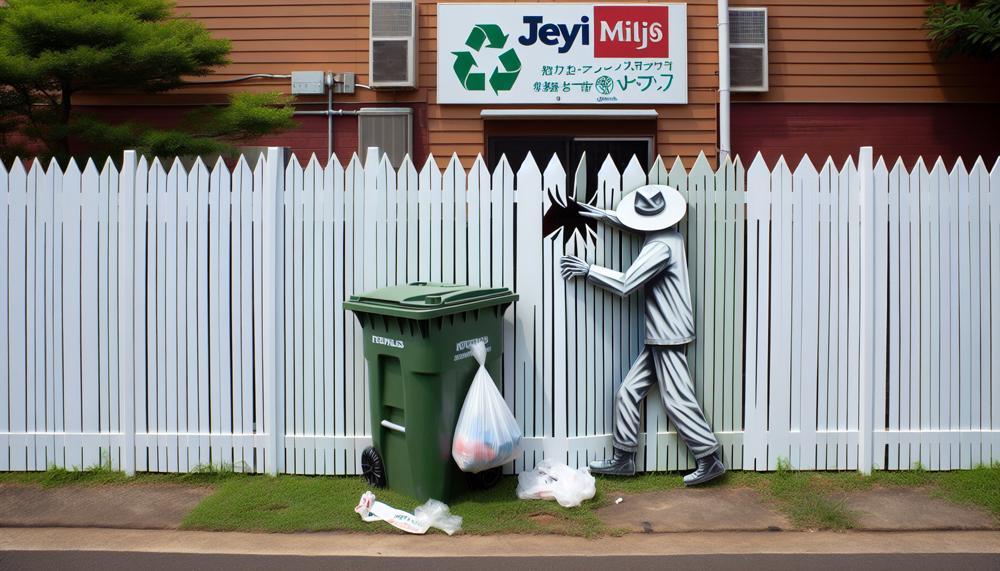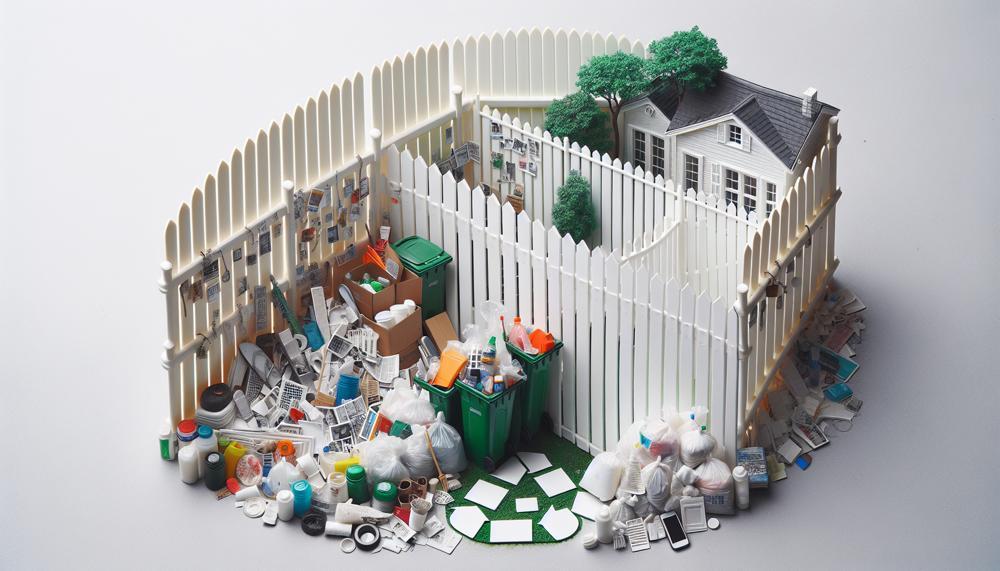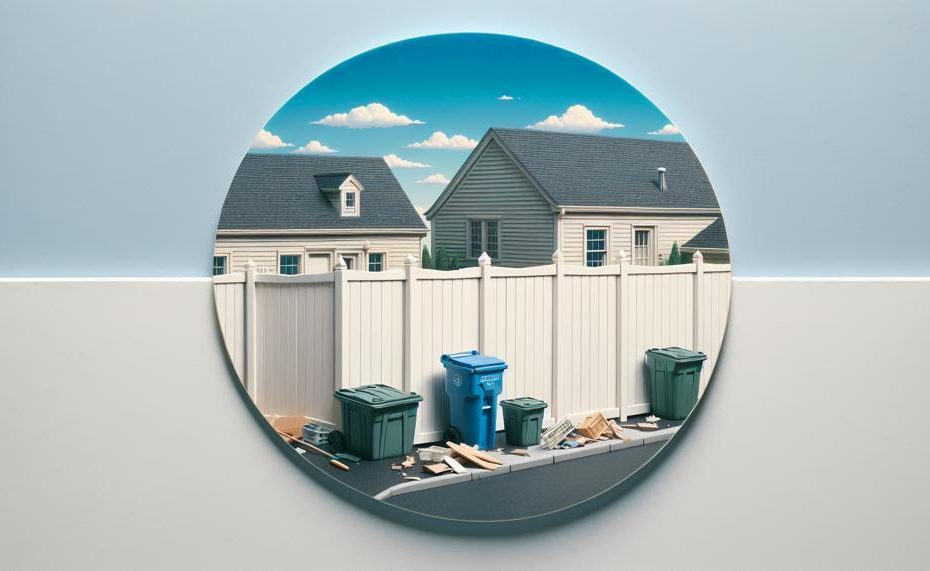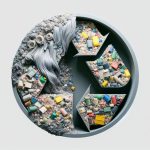Welcome to our blog, where we are dedicated to finding eco-friendly solutions for everyday living. Today, we want to shed light on a topic that often goes overlooked: recycling vinyl fencing.
Did you know that over 90% of the world’s plastic waste ends up in landfills or polluting our oceans? And as one of the most commonly used materials in the construction industry, vinyl fencing contributes significantly to this staggering statistic.
There is a solution: recycling. By choosing to recycle your old vinyl fence instead of sending it to a landfill, you are not only reducing pollution but also conserving natural resources. It’s a win-win situation for both the environment and your wallet.
Here are some key points to keep in mind:
- Vinyl fencing is made from PVC (polyvinyl chloride), which can be recycled into new products.
- Recycling just one ton of PVC can save up to 2.5 tons of CO2 emissions.
- By opting for recycled materials, you are supporting a circular economy and reducing the demand for virgin resources.
So, why isn’t vinyl fencing being recycled more often? Stick around as we delve deeper into this issue and explore ways in which we can all play a part in promoting a more sustainable future. Let’s join forces and make a positive impact on our planet.
Contents
- 1 Vinyl Fencing is No Regular plastic.
- 2 Can you recycle vinyl fencing?
- 3 Vinyl Fencing is a Thermoplastic: Why is this Important?
- 4 Recycling Plastics: A Messy Business
- 5 Good Environmental Intentions Exposed
- 6 China’s Ban on Plastic Recycling Imports: Detriment or Benefit?
- 7 Delivering Scrapped Vinyl Fencing to a Local Recycling Center is still a Good Solution
- 8 Recycling Vinyl Fencing Directly with the Manufacturer is Best for the Environment
- 9 Major Vinyl Fencing Recycling Centers Accept Discarded Materials
- 10 Conclusion
Vinyl Fencing is No Regular plastic.
As we explore the best way to recycle vinyl fencing, it’s crucial to understand the key differences between this material and regular plastic. These differences encompass the composition, manufacturing process, recycling process, and potential health hazards. By being aware of these distinctions, you can make informed choices when purchasing and disposing of these materials, ensuring a more sustainable future.
In terms of composition, vinyl fencing contains a higher percentage of PVC resin compared to regular plastic. This makes it more durable and resistant to weathering, making it a popular choice for outdoor fencing. On the other hand, regular plastic can be made from various materials, such as PE, PP, and PS, which may not have the same strength and durability as PVC resin.
The manufacturing process also sets vinyl fencing apart from regular plastic. It is primarily made through extrusion, a process that involves melting and shaping the material into its desired form. In contrast, regular plastic can be produced using different methods, such as injection molding or blow molding.
Can you recycle vinyl fencing?
Vinyl fencing requires specialized recycling facilities due to its complex composition. This makes it more challenging to recycle compared to regular plastic, which can be melted and reformed using more common methods. Therefore, when choosing to recycle vinyl fencing, it is essential to ensure that it is done in a proper facility to avoid any potential harm to the environment.
Lastly, vinyl fencing contains chemicals such as phthalates and dioxins that may pose health risks if not handled or disposed of properly. These chemicals are commonly found in PVC resin and can be harmful to both humans and the environment if released into the air or water.
It is crucial to handle and dispose of vinyl fencing carefully to prevent any potential hazards.
Vinyl Fencing is a Thermoplastic: Why is this Important?
Vinyl fencing is classified as a thermoplastic due to its primary component, polyvinyl chloride (PVC). This type of plastic can be melted and molded repeatedly without losing its inherent properties, making it highly versatile and durable.
This property has significant implications for recycling as it enables the material to be melted down and repurposed into new products, promoting sustainability and reducing waste in landfills.
In today’s world, where environmental awareness is increasingly crucial, the ability to recycle and reuse materials is vital. In this context, vinyl fencing stands out as an excellent option for fencing due to its thermoplastic nature.
Unlike other fence materials that are difficult to recycle or end up in landfills, vinyl fencing can be melted down and used to create new products. This not only reduces the amount of waste but also promotes a circular economy where resources are reused and conserved.
Furthermore, vinyl fencing’s thermoplastic nature makes it highly durable and long-lasting, minimizing the need for replacement and reducing the overall environmental impact.
This property also makes it an ideal choice for outdoor use as it can withstand harsh weather conditions without deteriorating or losing its structural integrity.
Recycling Plastics: A Messy Business
Vinyl fencing, unlike other plastics, has a unique recycling process that sets it apart in terms of energy requirements, quality of recycled material, and demand for recycled material.
Due to its chemical composition, PVC is challenging to recycle alongside other plastics and must be separated during the recycling process. Furthermore, it requires a higher melting temperature, leading to increased energy consumption.
The limited potential for reusing PVC also affects the quality of recycled vinyl fencing. Moreover, there is not a significant demand for recycled PVC material compared to other types of plastic.
However, with advancements in recycling technology and support from consumers, we can enhance the recycling process and promote sustainability.
The intricate process of recycling vinyl fencing highlights the importance of separating it from other plastics. This process involves separating PVC from other plastics before melting it at a higher temperature, resulting in increased energy consumption.
As a result, it is crucial to educate individuals about the proper disposal of vinyl fencing to avoid contaminating other plastics and contributing to unnecessary energy consumption.
The limited reuse potential of PVC presents challenges in producing high-quality recycled vinyl fencing. This quality difference can negatively impact the demand for recycled PVC material.
Therefore, promoting sustainable practices and consumer support for recycled PVC can help increase demand and improve the recycling process overall.
Good Environmental Intentions Exposed
The importance of good environmental intentions cannot be overstated when it comes to recycling vinyl fencing.
These intentions drive individuals and companies to seek sustainable solutions for disposing of old fencing, ultimately supporting eco-friendly practices.
Uncovering the Environmental Impact of Vinyl Fencing
Vinyl fencing, commonly made from polyvinyl chloride (PVC), is a non-biodegradable plastic that can take hundreds of years to decompose.
This poses a significant threat to the environment, as it can release harmful chemicals and pollutants into the soil and water if not disposed of properly.
Moreover, the production of PVC emits toxic chemicals, contributing to air and water pollution.
Challenges in Recycling Vinyl Fencing
Recycling vinyl fencing can be a daunting and costly task due to its plastic composition. The high levels of PVC in vinyl make it difficult to separate from other materials, requiring specialized equipment and processes.
As a result, many recycling centers do not accept vinyl fencing, making it a less accessible option for disposal.
The Power of Good Environmental Intentions in Driving Sustainable Solutions

Individuals with good environmental intentions play a crucial role in promoting sustainability in the recycling of vinyl fencing.
By choosing to recycle their old fencing instead of throwing it away, they prevent it from ending up in landfills and polluting the environment. Furthermore, opting for low PVC content when purchasing new fencing makes it easier to recycle in the future.
Companies and Manufacturers Taking Action Towards Recycling
Many companies have recognized the importance of recycling vinyl fencing and offer recycling services for their products. Some manufacturers even use recycled PVC material in their new products, reducing their environmental impact.
By supporting these companies, individuals with good environmental intentions can encourage others to join in and promote sustainability.
The Undeniable Environmental Benefits of Vinyl Fencing
Despite its challenges in recycling, vinyl fencing has several environmental benefits that make it a desirable choice. Its durability and low maintenance requirements mean it lasts longer than other materials, reducing the need for frequent replacements.
Additionally, its recyclable nature allows it to be repurposed or recycled into new products, reducing waste and promoting a circular economy.
China’s Ban on Plastic Recycling Imports: Detriment or Benefit?
China’s decision to ban the import of plastic waste has had a significant impact on the recycling industry, causing disruptions and exposing flaws in current systems. However, amid the challenges, it also presents potential benefits in promoting innovation and reducing plastic consumption.
Impact on the Recycling Industry:
- Global Disruptions: The ban has had a ripple effect on the global recycling market, leading to a decrease in demand for plastic waste. This has resulted in many countries struggling to find alternative solutions for managing their plastic waste, resulting in an increase in landfills and incineration.
- Flaws Exposed: China’s ban has shed light on the flaws in the recycling systems of many Western countries. These countries were exporting a large portion of their plastic waste instead of properly managing it within their own borders. This highlights the urgent need for more sustainable and efficient waste management practices.
- Exporting Waste: To cope with the ban, some countries have turned to exporting their plastic waste to other Southeast Asian nations with less strict environmental regulations. However, this raises concerns about potential environmental and social issues in these regions.
Potential Benefits of the Ban:
- Promoting Responsibility and Innovation: The ban has forced Western countries to take responsibility for their own recycling and invest in developing more sustainable solutions. Furthermore, it has encouraged innovation in the recycling industry, leading to investments in new technologies and methods.
- Increased Awareness: China’s ban has also raised awareness about the need for reducing plastic consumption and promoting more sustainable alternatives. This has resulted in an increase in initiatives aimed at reducing plastic waste globally.
- Highlighting Long-Term Sustainability: With China no longer demanding recycled plastics, there are concerns about the long-term sustainability of the recycling industry without a major market for recycled materials. This emphasizes the need for more sustainable practices and solutions.
In conclusion, China’s ban on plastic recycling imports has had both positive and negative impacts on the recycling industry.
Delivering Scrapped Vinyl Fencing to a Local Recycling Center is still a Good Solution
Delivering scrapped vinyl fencing to a local recycling center is an effective and environmentally responsible method of disposing of old fencing materials. The process involves several steps that ensure the proper recycling of PVC materials.
Firstly, it is crucial to prepare the scrapped vinyl fencing before delivering it to the recycling center. This includes removing any hardware, screws, or nails and cutting the fence into manageable pieces for easier transportation.
Next, finding a specialized recycling center that accepts vinyl for processing is essential. Not all recycling facilities have the capability to recycle PVC materials, so it is crucial to identify a suitable one beforehand.
Once you have prepared the fencing and identified a suitable recycling center, you can drop off the materials at the designated location. The vinyl will then be sorted from other materials, such as metal and wood, at the facility.
After sorting, the vinyl will go through a shredding process, breaking it down into smaller pieces for easier processing. The shredded vinyl is then transformed into molten form and molded into new products.
Delivering scrapped vinyl fencing to a local recycling center not only promotes sustainability and waste reduction but also contributes to a more circular economy. By reusing and repurposing the vinyl instead of sending it to landfills, natural resources are conserved and waste is reduced.
Additionally, as vinyl fences have a longer lifespan compared to other materials, there is less waste over time and fewer replacements needed.
Recycling Vinyl Fencing Directly with the Manufacturer is Best for the Environment
Recycling vinyl fencing directly with the manufacturer has numerous benefits for the environment. These include reducing waste in landfills, conserving resources, promoting a circular economy, and cutting down greenhouse gas emissions.
Let’s take a closer look at each of these benefits in detail.
Reducing Waste in Landfills:
Instead of disposing of old vinyl fencing in landfills, recycling it can significantly reduce the amount of waste that ends up in these facilities. In turn, this not only alleviates the strain on landfills but also reduces the need for new ones to be built.
Conserving Resources:
The production of vinyl fencing requires non-renewable resources like fossil fuels. By recycling old fencing, we can decrease the demand for these resources and help conserve them for future generations.
Promoting a Circular Economy:
Recycling directly with manufacturers promotes a circular economy where materials are repurposed to create new products instead of being discarded after one use. This not only cuts down on the need for new raw materials but also conserves resources, ultimately benefiting the environment.
Cutting Down Greenhouse Gas Emissions:
The production of vinyl fencing contributes to greenhouse gas emissions, which have a negative impact on the environment.
By recycling old fencing, we can reduce the energy and resources needed to produce new fencing, resulting in lower greenhouse gas emissions.
Major Vinyl Fencing Recycling Centers Accept Discarded Materials

There are numerous recycling centers located throughout North America that accept discarded materials from vinyl fencing. Some prominent centers include:
| Vinyl Recycling, LLC | Situated in San Jose, California, this company specializes in the environmentally-friendly process of recycling various types of plastic, including vinyl. | https://www.vinylrecyclingllc.com/ |
| Green Tree Plastics | Based in Indiana, this recycling center accepts a wide range of plastic materials for recycling, including vinyl fencing. | https://www.greentreeplastics.com/ |
| Earth911 | An online resource that connects individuals with local recycling options for various materials, such as vinyl fencing. | https://earth911.com/ |
| Waste Management | This company provides recycling services for a variety of materials across different locations in North America, including vinyl fencing. | https://www.wm.com/us/en/recycle-right/recycling-services-by-state |
| Vinyl Recycling Solutions | Situated in Ohio, this company specializes in recycling plastic materials, like vinyl, for reuse in various products. | http://vinylrecyclingsolutions.com/ |
These are just a few examples of major vinyl fencing recycling centers that accept discarded materials. Before dropping off your materials, it is best to do research and contact local centers to confirm if they accept this type of material.
Additionally, many local vinyl fence manufacturers may have their own recycling programs in place and may be open to accepting excess scrap material for reuse.
This not only supports recycling efforts but also contributes to the circular economy by reducing waste and promoting sustainable practices within the industry.
Conclusion
In conclusion, it is crucial that we recycle vinyl fencing to pave the way for a more sustainable future.
By opting for recycling instead of sending it to landfills, not only do we reduce pollution but also conserve our precious natural resources. Despite its challenges, such as the need for specialized recycling facilities and potential health hazards, the benefits of recycling vinyl fencing far outweigh the costs.
It promotes a circular economy, reduces greenhouse gas emissions, and raises awareness about responsible waste management. Let’s come together and take action towards a greener tomorrow by choosing eco-friendly solutions in our daily lives.
With the support of individuals and companies alike, we can make a positive impact on our earth.





